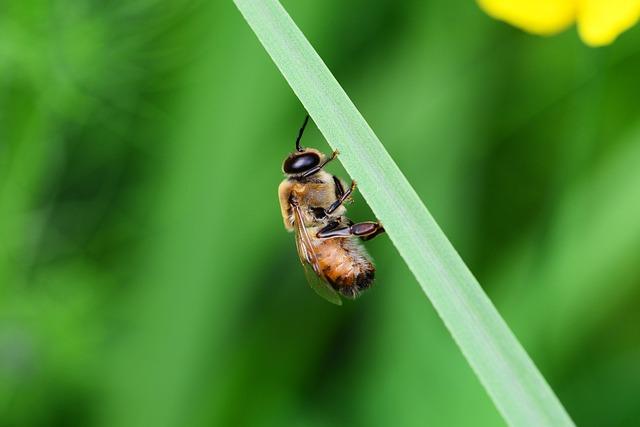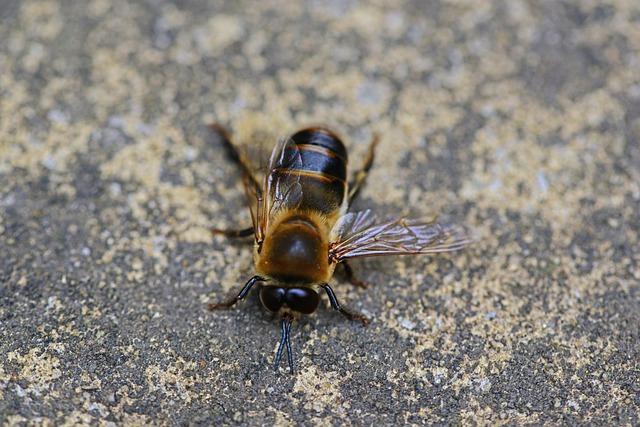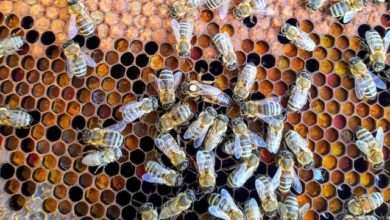Drones Bees

Most of the time we hear about bees, the queen and the worker bees are usually the center of the conversation.
What about their male counterparts?
Have you ever put much thought into the male honey bees?
They are just as important as their other counterparts with quite fascinating life journeys from their birth, to mating and eventually death. Interestingly, their mating and death are often quite close as extensively elaborated within the article.
Commonly referred to as drones, they usually comprise the larger bees hanging around the hives.
They mostly live in the hives during the periods of summer and spring but regularly leave to find Drone Congregation Areas (DCAs), where they gather with other drones in anticipation of being part of a mating flight and with luck eventually mate with a young queen.
As such, the primary purpose and focus of a drone bee is to mate with a queen. He waits high above the ground, suspended in the air among other drones in the DCA.
If a queen flies slightly outside the radar of this congregation area, they would go unnoticed. However, if the queen is detected within the range of the DCA, mating flight commences and there is a chance for a mating encounter.
The mating process of the bees is quite unique. The DCAs often comprise hundreds or even thousands of male honey bees and when a queen is detected, they all compete through flight and not fight. As such, the drone that manages to fly closest to the queen successfully mates.
Nevertheless, the drones often have a somewhat limited role compared to the queen and the worker bees, in fact, some may even conclude that they are the most ineffective and unhelpful bees in the hives.
And, while there may be some small truth to this, the drones are absolutely essential since they offer something mandatory for the future of bees – genetic diversity.
This is essentially a fundamental requirement for the success of any colony given that a queen only mates during a brief period in her early life and, over the course of a small number of mating flights.
Therefore, when the queen mates with drones from numerous colonies, the hive’s genetic pool is broadened which in turn benefits the colony as they would have a much greater ability to resist disease.
The drones are also significant as they fulfill other hive functions, maybe not as furious as the worker bees though.
For instance, despite being considered ‘layabouts’ often not doing much when it comes to working around the hive, they occasionally help with cooling efforts when temperatures skyrockets within the hives by flapping their wings to disperse the heat.
Drones further serves the beekeepers by assuring them that the queens will be able to mate and ensure the continuity of a colony.
Therefore, beekeepers often take note of the swarm season when drones begin appearing in the early spring. This is significant because without a way for the queens to mate, they will not often leave their hives and this could have detrimental consequences to the continuity of the colony.
The Anatomy of a Drone Bee
Drone bees are usually easy to spot as they have a quite unique appearance to the other bees. They weigh about as much as the queen bee but with numerous distinguishing features. As such;
- They are thicker than the queen.
- They have a thick abdomen and long legs, these are however hidden by the stomach most of the time.
- They have a more box-shaped stomach compared to the worker or queen bee stomachs.
- They have a very round head.
- Their eyes seem much closer compared to those of the other bees.
- They have much larger eyes, their most distinguishing feature.
- They have very large wings that completely cover their stomachs.
- They have an appendage tucked within that protrudes when fulfilling their main purpose of mating.
How Drones are Born
Drones develop from unfertilized eggs laid by the queen in specific cells. The queen often bases her fertilization decisions upon the size of the cells built by the worker bees.
The worker bees are in turn directed by the hive’s need for each caste at any point in the colony’s development.
Therefore, the cells that are much larger are usually designated for the unfertilized queen eggs and the queen knows where to lay these eggs.
It is also important to note that drone bees only have a grandfather but no father.
This stems from the fact that drones develop from unfertilized eggs and as such, they only receive their genetic components from the queen. And, since, the queen is female and developed from a fertilized egg, they had a father which is in turn, the drone’s grandfather.
Once the egg is laid by the queen, it becomes a larva and, in the meantime, the worker bees will continually feed it royal jelly for the better part of 2 to 3 days.
The royal jelly is rich in protein needed to kickstart the overall development of the drone bees.
Afterward, they are only fed bee bread, which is essentially a hearty mixture of honey and pollen for their nourishment and sustenance throughout their respective development stages.
As such, after a drone’s development from larva and pupa stages are complete in 24 days, they hatch.
Drone Cells
The worker bees create varying cells for different bees. Then, how would you recognize and distinguish a drone cell from the rest?
It is quite easy as they have very distinct features.
- They are laid in proximity to each other and usually at the bottom of the frame
- They are larger in diameter than a worker bee cell.
- Their caps appear higher and more rounded at the top compared to a worker bee cell.
- They are shaped like bullets.
It is important to watch out for the drone broods since mites often prefer feeding on them as they take longer to hatch.
The capped drone cells thus offer a comfortable and much easier food source for the mites. In fact, capping of the drone cells also takes much longer than other cells and this gives the mites ample time to get into these cells and reproduce.
Reproductive Role and Genetic Diversity
The drones usually offer more than just a successful mating session, due to their ability to mate with a single queen, since they also guarantee the essential benefit of genetic diversity for the assured continuity of the colony.
Female honey bees have a total of 32 chromosomes, half of which come from the queen and the other half from the drone’s genetic composition.
By comparison, the drone bees only have a total of 16 chromosomes. Therefore, during mating, the drone provides all their genetics for the rearing of future probable female and worker bees which have diploid (32) chromosomes.
Therefore, the queen usually mates with multiple drones to improve the chances of greater sperm selection which essentially guarantees the subsequent colony’s generation of bees being stronger and more resilient to things like diseases.
As such, the drone that usually succeeds in mating with the queen is often subjected to vigorous competition with other hundred or even thousands of drones, depending upon their population within the specific drone congregation area.
The End of Life for a Drone Bee
The drone’s mating and death are usually adjacent with one leading to the other.
Therefore, when the drone mates with the queen, the semen is usually released with such a force that rips his endophallus from his abdomen. With a ripped abdomen, the drone essentially dies shortly afterward.
Kicked Out of the Hive
The drones also die from being kicked out of the hive by worker bees and not only from having sex. This often happens in the fall when foraging becomes scarce and the drones become just extra mouths to feed in the hive without contributing much.
The worker bees usually starve the drones, weaken them and eventually escort them to the hive entrance throwing them out of the hive. They get exposed to starvation and hypothermia while outside the hive eventually leading to their deaths.
Frequently Asked Questions (FAQs)
What is a honey bee Drone Congregation Area (DCA)?
A DCA is a specific zone high above in the air where male honey bees gather in large numbers awaiting a young queen to visit for mating.
These mating areas are unique from most given that they are usually suspended high in the air and thus situated above ground. Therefore, unlike numerous other animals and insects, honey bee mating takes place in the air and not on the ground or even in the hive.
The drone congregation areas bring drones and queens together from a wide area, thus guarding against any form of inbreeding that may inhibit genetic diversity and associated benefits.
A study from Germany indicates that just a single DCA could contain drones from up to 240 different colonies spread over a large area.
Another study also estimated that a single DCA could contain drones from several hundred to about 30,000 drones which guarantee adequate gene mixing during mating.
Where do you find a Drone Congregation Area?
There is no exact pinpointed location of a DCA. However, estimations from various sources usually place the drone congregation areas to be 5-35 meters (16-115 feet) above the ground while measuring 30-200 meters (100-650 feet) wide across the air.
As such, if you would dye such a congregation of drones, it would appear like a traffic cone, wide at the bottom and narrow at the top.
Interestingly, these DCAs often reappear in similar locations every year despite the drones’ short lifespan of only a few weeks and the queens mating only in the first year.
Several speculative theories by researchers have attributed this to more than just the genetic memory of the newly hatched drones. These theories include;
- Specific geographical features and vegetation patterns
- Male pheromones attracting the drones to each other, among others.
The drone congregation areas may often be several within an area with multiple honey bee colonies. The drones may often fly between these areas on pre-established routes known as flyways.
Therefore, a drone can always fly from one DCA to another trying its luck in different locations due to stiff flight competition from subsequent DCAs. As such, watching an active DCA from below often sounds like a swarm.
How many drones will usually mate with the queen?
The queen will usually mate with about 10 to 20 drones during her mating flights. However, a recent study found that some honey bee queens mated with up to 50 drones cumulatively on the different days of their mating flights.
Do drone bees do anything?
Drone bees’ sole purpose is to mate with the queen. They, therefore, don’t usually work, make honey, or even sting. Since the queen only needs to mate once, most of these drones don’t even get to fulfill their main purpose and therefore die without doing anything.
Worker bees keep them around just in case a new queen emerges or for emergency assistance in cooling down the hives in hot temperatures.
Which bee can lay a drone egg?
Since the drone eggs are not fertilized, they are the only eggs that can be laid by either the queen or a worker bee.
Do drone bees sting?
Despite being larger than the worker bees, they are usually stingless unlike their queen and worker counterparts who have stingers and thus can effectively sting.
Should I destroy drone cells?
This usually depends on how bad the condition has gotten. In most cases, the equipment should be destroyed when a large percentage of the worker cells have been transformed into drone cells.
You can however always scrape off the remaining neglected drone brood and place the frame into a strong colony and it would just be fine.
Should you remove the drone comb?
There is usually no strategic point in removing a drone comb since the bees themselves will just replace it. Bees will only ever raise as many drones as they need to ensure the continuity of the colonies.
What do drone bees do all day?
It is often said that drones spend most of their short life drinking nectar, lazing around on flowers, and of course seeking a mate before mating and dying.
In fact, several studies conducted on this subject have often concluded that drone bees are just ‘Lazy Willis’, others even going beyond to refer to them as ‘flying sperms’ only necessary for the insemination of virgin bee queens.
Why is my beehive full of drones?
This usually reflects to poor mating of the queen and thus, she is essentially giving birth mostly to unfertilized eggs.
The drone cells are easy to identify as they have distinguishing features being doomed, larger, and grouped together on the outer edges of the frame when compared to worker bee cells.
Do drones mate with their own queen?
Not necessarily since they always leave their respective hives and colonies to gather in the DCAs to fulfill their purpose which is only mating with an unfertilized queen.
What percentage of a hive are drones?
A healthy and well-fed colony usually has approximately 15 percent of the drone bees’ population.
Therefore, if you don’t see drones in your hive, majorly in the summer or a significant number, then it is likely that your colony has a problem and as such, you should look into it.
Where do drone bees go during the winter periods?
They usually form a winter cluster by staying inside the hive and creating a big hurdle to keep them as warm as possible during this cold season.
The queen is usually enclosed at the center of the cluster for warmth and safety and the colder the temperatures, the more compact the cluster becomes to ensure every heat is retained.
What kills a drone bee?
Apart from the mating aftermath, the drone bees are usually killed by their worker bee counterparts. Therefore, when the time comes, the worker bees mercilessly kill the drones by condemning them to starvation and hyperthermia.







